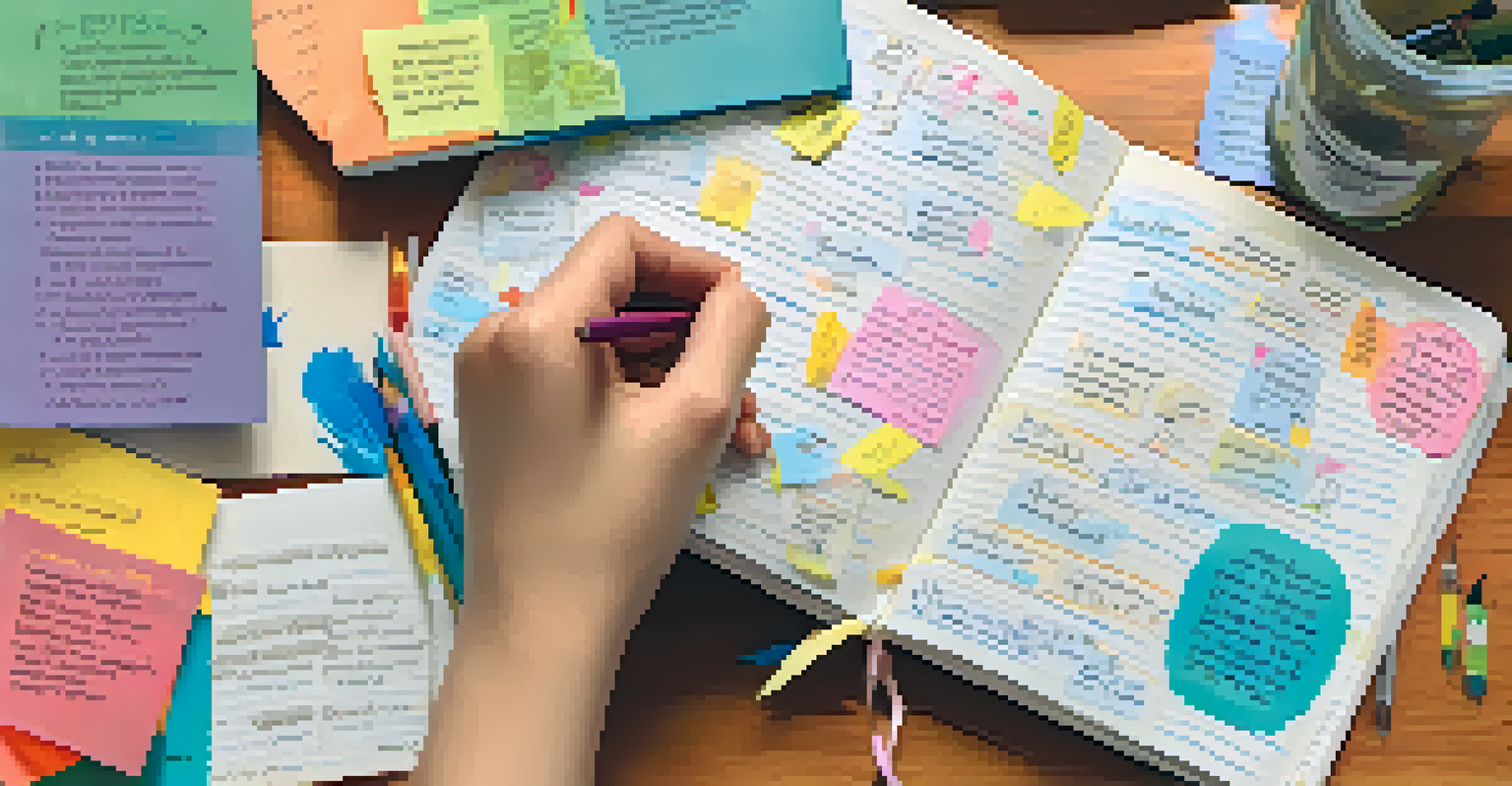Cognitive Behavioral Approaches to Improve Focus in Class

Understanding Cognitive Behavioral Approaches
Cognitive Behavioral Therapy (CBT) is a psychological approach that helps individuals identify and change negative thought patterns. In the context of improving focus in class, CBT techniques can be incredibly effective. By understanding how thoughts influence behaviors, students can learn to refocus their attention when distractions arise.
The greatest weapon against stress is our ability to choose one thought over another.
For example, if a student finds themselves daydreaming during a lecture, a CBT strategy would involve recognizing that wandering thought and consciously redirecting focus back to the teacher. This process not only enhances concentration but also builds a habit of mindfulness. Over time, these techniques can significantly improve a student's ability to stay engaged.
Ultimately, integrating cognitive behavioral approaches into daily routines can empower students to take control of their learning environment. By fostering self-awareness and resilience, these strategies can lead to lasting improvements in academic performance.
Identifying Distractions and Triggers
The first step in using cognitive behavioral strategies is to identify what distracts you in class. Common distractions include noise, technology, or even internal thoughts like anxiety about upcoming tests. Recognizing these triggers is essential for developing effective coping strategies.

For instance, if a student is easily distracted by their phone, they could use a CBT technique known as 'thought stopping' to halt those urges. This involves acknowledging the distraction and consciously deciding to put the phone away. By identifying and addressing specific distractions, students can create a more conducive learning atmosphere.
Cognitive Behavioral Techniques
CBT helps students identify and modify negative thought patterns to improve focus and engagement in class.
Understanding and addressing these triggers not only helps maintain focus but also builds a framework for self-discipline. This awareness can lead to a proactive approach to learning, where students anticipate distractions before they arise.
Setting Realistic Focus Goals
Setting achievable focus goals is crucial for any student looking to enhance their classroom experience. Rather than aiming for a perfect concentration level, it's more effective to establish small, measurable goals. For example, a student might set a goal to concentrate for 20 minutes before taking a short break.
Mindfulness isn't difficult, we just need to remember to do it.
These incremental goals can be adjusted as students become more skilled at maintaining focus. Celebrating small wins along the way can also boost motivation and reinforce positive behavior. Additionally, students can use techniques like the Pomodoro Technique, which involves focused work sessions followed by short breaks.
By setting realistic goals, students learn to pace themselves and develop a sustainable focus routine. This approach not only combats burnout but also encourages consistent improvement in attention and productivity.
Practicing Mindfulness Techniques
Mindfulness is a powerful tool in cognitive behavioral approaches, helping students stay present during lessons. Techniques such as deep breathing, meditation, or even mindful listening can enhance focus. For instance, taking a few moments to breathe deeply before class can help clear the mind and prepare for learning.
By incorporating mindfulness practices into their daily routine, students can train their minds to focus better. This can be as simple as taking a moment to notice surroundings or focusing on the teacher's voice without letting distractions interfere. Over time, these practices foster a natural ability to concentrate.
Mindfulness Enhances Concentration
Practicing mindfulness techniques, such as deep breathing, can help students stay present and focused during lessons.
Moreover, mindfulness encourages a positive mindset, reducing anxiety and stress that can hinder focus. When students feel more relaxed and present, they can absorb information more effectively, leading to improved academic performance.
Utilizing Positive Affirmations
Positive affirmations can significantly impact a student's ability to focus in class. By repeating encouraging phrases, students can combat negative self-talk that may arise when they struggle to concentrate. For example, saying to oneself, 'I am capable of staying focused' can help shift mindset and bolster confidence.
These affirmations can be used before class or during moments of distraction. They serve as a reminder of one's abilities and potential, reinforcing the belief that focus is achievable. This practice aligns perfectly with the principles of cognitive behavioral therapy, which emphasizes the connection between thoughts and behaviors.
Incorporating positive affirmations into a daily routine can create a supportive self-dialogue. Over time, this can lead to improved self-esteem and a greater ability to maintain focus when it matters most.
Creating a Conducive Learning Environment
A well-structured learning environment is essential for maintaining focus in class. Factors such as seating arrangements, lighting, and minimizing noise can make a significant difference. For instance, students sitting near the front of the class may find it easier to concentrate than those at the back.
Additionally, personalizing one’s study space can also enhance focus. This could involve organizing materials, reducing clutter, or even using noise-canceling headphones during study sessions. By creating an environment that minimizes distractions, students can better direct their attention toward learning.
Set Achievable Focus Goals
Establishing small, realistic focus goals enables students to maintain attention and avoid burnout while learning.
Ultimately, a conducive learning environment supports cognitive behavioral strategies by reducing external triggers. When students feel comfortable and focused, they're more likely to engage with the material and retain what they learn.
Reflecting on Progress and Adjusting Strategies
Regular reflection is key to understanding what strategies work and what may need adjustment. Keeping a journal to track focus levels and the effectiveness of various techniques can be incredibly helpful. This practice allows students to see patterns, celebrate successes, and identify areas for improvement.
For example, if a student notices they remain more focused on days when they use mindfulness techniques, they can make a conscious effort to incorporate those practices more regularly. Adjusting strategies based on personal observations enhances the effectiveness of cognitive behavioral approaches.

By reflecting on progress, students can cultivate a growth mindset, viewing challenges as opportunities for learning. This continuous cycle of assessment and adjustment encourages resilience and ultimately leads to improved focus in class.